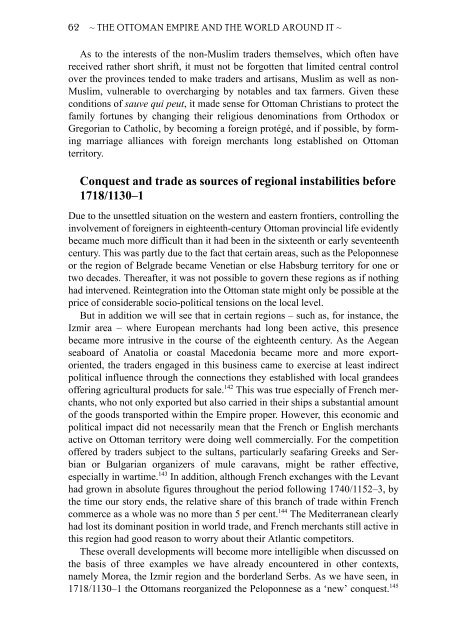The Ottoman Empire and the World Around It - Course Information
The Ottoman Empire and the World Around It - Course Information
The Ottoman Empire and the World Around It - Course Information
Create successful ePaper yourself
Turn your PDF publications into a flip-book with our unique Google optimized e-Paper software.
62 ~ THE OTTOMAN EMPIRE AND THE WORLD AROUND IT ~<br />
As to <strong>the</strong> interests of <strong>the</strong> non-Muslim traders <strong>the</strong>mselves, which often have<br />
received ra<strong>the</strong>r short shrift, it must not be forgotten that limited central control<br />
over <strong>the</strong> provinces tended to make traders <strong>and</strong> artisans, Muslim as well as non-<br />
Muslim, vulnerable to overcharging by notables <strong>and</strong> tax farmers. Given <strong>the</strong>se<br />
conditions of sauve qui peut, it made sense for <strong>Ottoman</strong> Christians to protect <strong>the</strong><br />
family fortunes by changing <strong>the</strong>ir religious denominations from Orthodox or<br />
Gregorian to Catholic, by becoming a foreign protégé, <strong>and</strong> if possible, by forming<br />
marriage alliances with foreign merchants long established on <strong>Ottoman</strong><br />
territory.<br />
Conquest <strong>and</strong> trade as sources of regional instabilities before<br />
1718/1130–1<br />
Due to <strong>the</strong> unsettled situation on <strong>the</strong> western <strong>and</strong> eastern frontiers, controlling <strong>the</strong><br />
involvement of foreigners in eighteenth-century <strong>Ottoman</strong> provincial life evidently<br />
became much more difficult than it had been in <strong>the</strong> sixteenth or early seventeenth<br />
century. This was partly due to <strong>the</strong> fact that certain areas, such as <strong>the</strong> Peloponnese<br />
or <strong>the</strong> region of Belgrade became Venetian or else Habsburg territory for one or<br />
two decades. <strong>The</strong>reafter, it was not possible to govern <strong>the</strong>se regions as if nothing<br />
had intervened. Reintegration into <strong>the</strong> <strong>Ottoman</strong> state might only be possible at <strong>the</strong><br />
price of considerable socio-political tensions on <strong>the</strong> local level.<br />
But in addition we will see that in certain regions – such as, for instance, <strong>the</strong><br />
Izmir area – where European merchants had long been active, this presence<br />
became more intrusive in <strong>the</strong> course of <strong>the</strong> eighteenth century. As <strong>the</strong> Aegean<br />
seaboard of Anatolia or coastal Macedonia became more <strong>and</strong> more exportoriented,<br />
<strong>the</strong> traders engaged in this business came to exercise at least indirect<br />
political influence through <strong>the</strong> connections <strong>the</strong>y established with local gr<strong>and</strong>ees<br />
offering agricultural products for sale. 142 This was true especially of French merchants,<br />
who not only exported but also carried in <strong>the</strong>ir ships a substantial amount<br />
of <strong>the</strong> goods transported within <strong>the</strong> <strong>Empire</strong> proper. However, this economic <strong>and</strong><br />
political impact did not necessarily mean that <strong>the</strong> French or English merchants<br />
active on <strong>Ottoman</strong> territory were doing well commercially. For <strong>the</strong> competition<br />
offered by traders subject to <strong>the</strong> sultans, particularly seafaring Greeks <strong>and</strong> Serbian<br />
or Bulgarian organizers of mule caravans, might be ra<strong>the</strong>r effective,<br />
especially in wartime. 143 In addition, although French exchanges with <strong>the</strong> Levant<br />
had grown in absolute figures throughout <strong>the</strong> period following 1740/1152–3, by<br />
<strong>the</strong> time our story ends, <strong>the</strong> relative share of this branch of trade within French<br />
commerce as a whole was no more than 5 per cent. 144 <strong>The</strong> Mediterranean clearly<br />
had lost its dominant position in world trade, <strong>and</strong> French merchants still active in<br />
this region had good reason to worry about <strong>the</strong>ir Atlantic competitors.<br />
<strong>The</strong>se overall developments will become more intelligible when discussed on<br />
<strong>the</strong> basis of three examples we have already encountered in o<strong>the</strong>r contexts,<br />
namely Morea, <strong>the</strong> Izmir region <strong>and</strong> <strong>the</strong> borderl<strong>and</strong> Serbs. As we have seen, in<br />
1718/1130–1 <strong>the</strong> <strong>Ottoman</strong>s reorganized <strong>the</strong> Peloponnese as a ‘new’ conquest. 145


